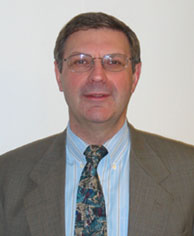 When Yuri Persidsky, M.D., Ph.D., came to UNMC in 1994, he had an idea to develop a small animal model to study HIV in the brain.
When Yuri Persidsky, M.D., Ph.D., came to UNMC in 1994, he had an idea to develop a small animal model to study HIV in the brain.
Nearly a decade later, the severe combined immunodeficiency (SCID) mouse model for HIV-1 infection of the brain that Dr. Persidsky developed with Howard Gendelman, M.D., has become recognized in the scientific community on several fronts, including its uniqueness in testing new medications’ effectiveness for treating HIV-1 cognitive impairment (collectively named HIV-1 associated dementia, or HAD).
“The mouse model is unique. It allows us to do research that others cannot do,” Dr. Persidsky said. “We use small animals repopulated with human cells infected with human virus for the drug efficacy testing in a setting that closely resembles human disease.”
|
Dr. Gilmore was professor and chairman of the department of physiology from 1970 to 1987. He was funded by the National Institutes of Health for his entire career, supervised numerous graduate students and post-doctoral fellows, and published more than 200 scientific papers. The Joseph P. Gilmore Award was established by the department of physiology and biophysics upon Dr. Gilmore’s retirement in 1987 to recognize outstanding research contributions by a faculty member. |
For his research efforts, Dr. Persidsky has been named this year’s recipient of the UNMC College of Medicine Joseph P. Gilmore Outstanding Investigator Award. Dr. Persidsky, an associate professor in the UNMC Department of Pathology and Microbiology, is a physician-scientist who combines active clinical service in anatomic pathology with basic research in the Center for Neurovirology and Neurodegenerative Disorders (CNND). Dr. Persidsky is the deputy director of the CNND and the chief of the Laboratory of Neuropathology/Neurovirology within the CNND.
“I was really happy when I heard that I’d won the award,” Dr. Persidsky said. “It’s not only recognition for what I’m doing, but this award is clear indication of the achievements of the entire CNND.”
A native of Kiev, Ukraine, Dr. Persidsky rose through the ranks at the Kiev Research Institute of Epidemiology and Infectious Diseases, becoming the head of the Laboratory of Pathology in 1988. In 1992, he took a position as a visiting scientist of the National Institute of Health and Medical Research (INSERM) in Strasbourg, France.
Through his experiences, Dr. Persidsky felt that he had the most opportunity for further scientific growth in the United States. In 1993, he learned that Dr. Gendelman, now the director of the CNND, had moved to UNMC, and Dr. Persidsky sent his curriculum vitae to Dr. Gendelman. Following an interview, Dr. Persidsky moved to Omaha with his wife, Raisa, and daughter, Anastasia.
“We were all very excited to come to Omaha,” Dr. Persidsky said. “I had a specific project in mind, to develop a small animal model for how HIV works in the brain.”
Dr. Persidsky and his colleagues performed experiments, utilizing the small animal model and an artificial blood-brain barrier model, comparing the results to human brain tissues derived from patients with HIV-1 encephalitis and HAD. Though further research, the small animal model allowed scientists to assess the efficacy of anti-retroviral and anti-inflammatory medications for treatment HIV-1 associated dementia. In 1996, Dr. Persidsky published the first journal paper on the subject. It was far from the last.
During the past decade, projects related to Dr. Persidsky’s research have resulted in more than 30 peer-reviewed publications. He has written book chapters and reviews for several journals and has presented his findings at numerous conferences. Dr. Persidsky is a principal investigator on three major NIH-funded grants.
One of the studies of Dr. Persidsky and his colleagues found that two drugs – abacavir, known as Ziagen, and lamivudine, also known as Epivir or 3TC – are the most effective against hard-to-treat HIV-1 hiding in the brain. Other studies have detailed how the blood-brain barrier plays a significant role in neuro-cognitive complications.
Currently, Dr. Persidsky and his colleagues are looking at the blood-brain barrier function, including expression of transport proteins protecting brain from toxic substances in the blood and hampering penetration of the therapeutic agents across the barrier. Dr. Persidsky’s lab explores the role of brain microvascular endothelial cells at the interface between blood and brain tissue in the infiltration of brain by white blood cells (leukocytes). It is believed that accumulation of HIV-1 infected leukocytes in the brain and their production of neurotoxins are responsible for the development of HIV-1 associated dementia. Since leukocytes migrate across endothelial cells at cell borders connected by junctional complexes (tight junctions), stabilization of tight junctions may prevent leukocyte brain accumulation and development of disease. In other studies, Dr. Persidsky is looking at how alcohol abuse affects the blood brain barrier’s function in the setting of HIV-1 brain infection.
As a clinician, Dr. Persidsky’s responsibilities include the areas of surgical pathology and renal pathology. For his roles as a physician and as a scientist, Dr. Persidsky extends much credit to Sam Cohen, M.D., Ph.D., chairman of the pathology/microbiology department.
“Dr. Cohen was very supportive in my efforts to pursue clinical work in combination with research,” Dr. Persidsky said.
Dr. Persidsky’s work as a clinician has helped him as a researcher, and vice versa.
“I’ve always been interested in new avenues, and part of my interest was always clinical,” Dr. Persidsky said. “Clinical work offers one viewpoint, and basic science is another. Combining them helps me put things in a completely new perspective.”